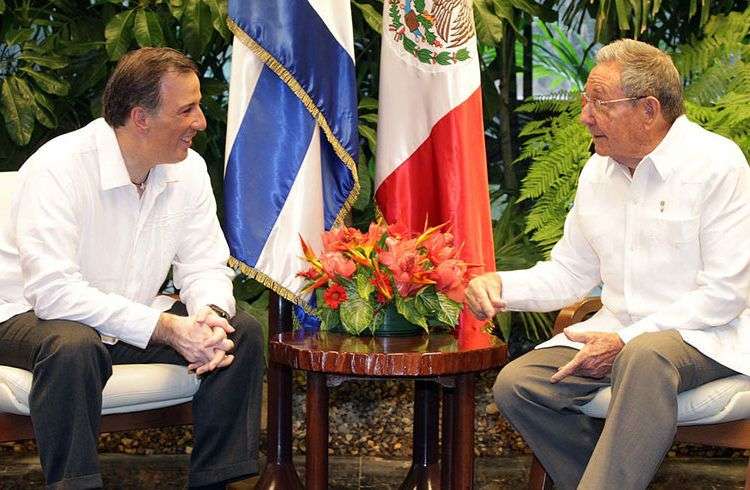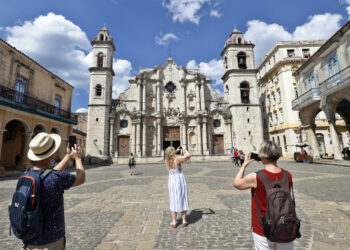From across the Yucatan Strait, the government of Enrique Peña Nieto is “very attentive to the process of updating the economic and social model promoted in Cuba and has expressed its full readiness to support it. There is growing interest in the Mexican private sector to be part of the changes taking place on the Island, “said the Minister of Foreign Affairs of that country, José Antonio Meade Kuribreña, during his recent visit to Havana.
The visit leaves the certainty that Mexico is about to become, along with Venezuela, Brazil, China and Russia, a big business partner of the economy of the island.
Cuba represents for Mexican entrepreneurs a nearby market of 11 million people, a place full of opportunities and eager for foreign investment. The interest in strengthening relations is evident.
Meade said, referring to the possibilities offered by the new Foreign Investment Law, that they “have been found attractive areas for investment in various sectors and cooperation on cultural issues.”
During his visit, he met with President Raul Castro and with Ricardo Cabrisas Ruiz, Vice President of Council of Ministers, with whom addressed, among other issues, diversification of the areas of economic exchange. Also he gave a lecture at the Higher Institute of Foreign Relations (ISRI), where he talked about the new deals signed between the two countries.
“There are 10 projects that are underway in sectors that deal with the construction, infrastructure, manufacturing, tourism, livestock, among others,” Meade said, adding that “we in Mexico want to have more investment and trade with Cuba and that leads us to be very aware of the updating process. ”
Oil is another issue of common interest. “As we share the Caribbean Sea as a tourist sea, we also share an area where large reserves are found,” the chancellor told reporters as he left the ISRI.
According to La Jornada, Mexican newspaper, Meade also announced that “the line of credit that had been extended to support on trade with Cuba” , a nation whose gross domestic product (GDP) increased by only 0.6 percent in the first half of 2014, which is below the 2.3 per cent achieved in the same period of 2013.
He also said that his country would like to see increased bilateral trade, “as it is currently around 500 million dollars a year. The trade balance favors Mexico in a meaningful way. I would expect that Cuba had greater export potential in areas of technology and services, “he said, noting that they are interested in the fields of food, chemical, energy and biotechnology industries.
With the current Mexican presidency the distance of more than a decade in bilateral relations seems to have concluded, uninterrupted since 1902. The recovery began under President Felipe Calderon, as trade grew from $ 219 million in 2007 to 510 million in 2012 .
Business with Mexico
In September 2013, Meade visited Havana invited by Chancellor Bruno Rodríguez Parrilla, in order to jointly review the overall state of relations and deepen the dialogue on bilateral and regional issues. Then eight agreements were signed.
Two months later, in November 2013 during a visit by Cuban Foreign Minister Bruno Rodriguez, Mexico forgave 70 percent of the island’s debt of $ 487 million and granted a period of 10 years to pay the remaining 30 per cent.
2014 has been particularly prolific in terms of meetings between political authorities of Cuba and Mexico. During the Second Summit of CELAC, the Cuban president met with his counterpart Enrique Peña Nieto and agreed to promote specific initiatives to strengthen relations.
Following that contact, since March the Pro México Commercial Consulting office works in the archipelago, and in May the first formal mission of Mexican businessmen came to Havana. “There are 10 projects that are underway in sectors that are related to building and infrastructure, tourism, manufacturing, farming, among others,” Meade said about it.
Recently, according to Official Gazette No. 32, Cuba granted tariff preferences to the Government of Mexico through a joint resolution signed between Cuban ministries of Foreign Trade and Foreign Investment and Finance and Prices. Thus, the Third Additional Protocol becomes reality and the Agreement of Economic Complementation No. 51, signed by both countries on November 2013.
The 80-page resolution benefit, mostly with 100 percent of tariff preferences, the import of food, chemicals, hygiene products, fabrics, purebred breeding animals, fuel, medicine, games for children and even antiques .
The Regional Tariff Preference (RAP), according to the Latin American Integration Association, is a percentage reduction of the duties applicable to imports from third countries, member countries are granted each other on imports of products originating in their respective territories.










